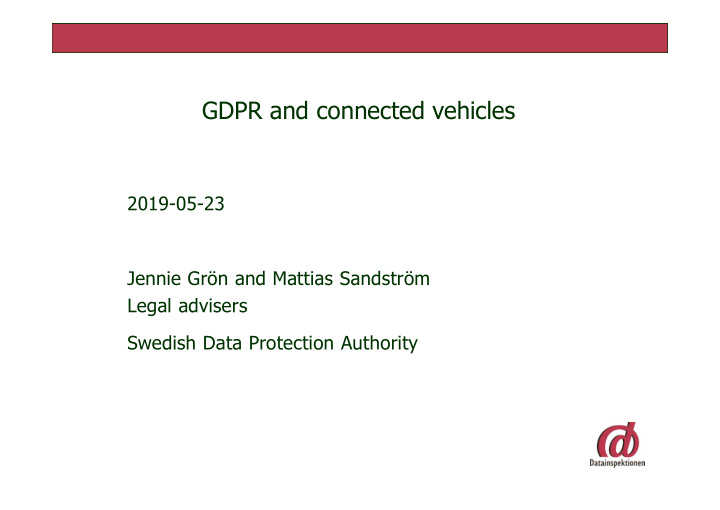



GDPR and connected vehicles 2019-05-23 Jennie Grön and Mattias Sandström Legal advisers Swedish Data Protection Authority
Right to privacy – a human right! European Convention on Human Rights Charter of Fundamental Rights of the European Union
Protection of personal data General Data Protection Regulation National legislation
Personal data Personal data only includes information relating to natural persons who: can be identified or who are identifiable, directly from the information in question; or who can be indirectly identified from that information in combination with other information.
• The license plate of a car is •Maria personal data if it can be related to a person ”…information relating to…” • The license plate of a company car that is used by several employees is not personal data (could be personal data with additional information)
Car location •Maria •“Just a few points in a path are enough to single out an individual in a population with a high degree of precision.” •– Opinion 03/2017 on processing personal data in the context of C-ITS, WP252, Art 29 Working Party.
Car location •Z82bb52!w Pseudonymization Security measure – still personal data
Special categories of personal data or criminal conviction and offences data These are considered to be more sensitive and you may only process them in more limited circumstances Examples: Special categories of personal data – biometric data Offence data - the instantaneous speed 80 of a vehicle combined with precise geolocation data Articles 9. 10
Key principles Lawfulness, fairness and transparency Purpose limitation Data minimisation Accuracy Storage limitation Integrity and confidentiality (security) Accountability
Lawful basis for processing Consent Processing i necessary for contract legal obligation vital interests exercise of official authority public interest legitimate interest
Accountability You are the one to demonstrate that you comply with the GDPR One of the fundamental data protection principles Keep evidence of the steps you take to comply Data protection measures in place through the lifecycle of processing operations Contracts in place where others process data on your behalf
Integrate privacy through development Both technical and organisational measures to protect the rights of data subjects Integrity risks should be taken into account from day one during the design stage (see privacy by design and default) Measures appropriate to the risks posed – evaluate risks early! High risk? – data protection impact assessment (article 35) Particularly when using new technologies Examples: Restricted access to data, local processing of data, pseudonymisation, short retainment periods, encryption, privacy-friendly user settings by default.
Vehicles and GDPR If it is necessary for car manufacturer X to process personal data for the purpose of roadworthiness Lawfulness – purpose limitation Lawful basis Special categories of data Data minimisation Data protection impact assessments – security Transparency
Opinions and Guidelines Article 29 Working Party Opinion 03/2017 on processing personal data in the context of Cooperative Intelligent Transport Systems (C-ITS) European Data Protection Board 2019/2020: Guidelines on Connected Vehicles Guidelines on Data Protection by Design and by Default Guidelines on concepts of controller and processor
Opinions and Guidelines European Data Protection Board (existing): Guidelines on consent Guidelines on processing personal data under Article 6(1)(b) – (processing is necessary for the performance of a contract) Guidelines on Data Protection Impact Assessment and determining whether processing is “likely to result in high risk” Guidelines on Transparency
Recommend
More recommend